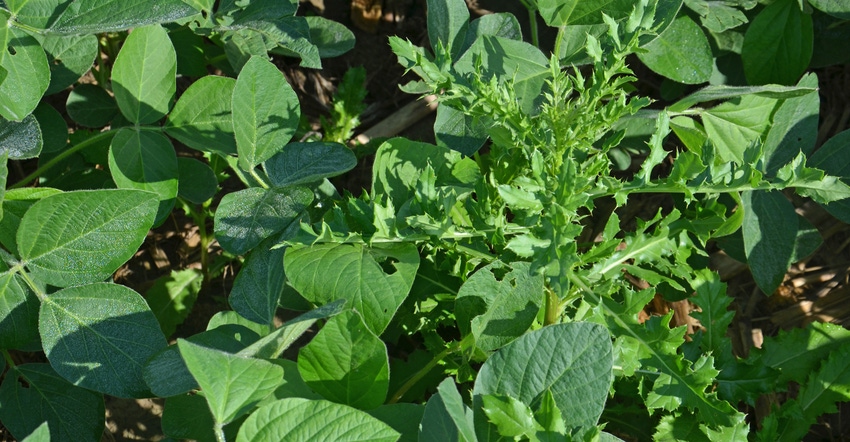
Steve Gauck loves working with soybeans. He hates weeds. That’s why the regional agronomy manager for Beck’s, Greensburg, Ind., is a stickler for weed control. If you can use a residual herbicide to keep weeds from germinating in the first place, do it. But if you’ve got weeds in the field and beans are up, get the weeds out as soon as possible, he says. Otherwise, they will zap yield potential before you even know they’re doing it.
During the first Soybean Watch three years ago, a patch of Canada thistles invaded a small area along a lane. Wet weather delayed postemergence herbicide application. Thistles were taller than beans when the field was sprayed.
“The operator knocked the thistles back, but the damage was already done,” Gauck recalls. “We checked that spot after the thistles dried up.
“Beans didn’t branch as much because they were competing with the thistles. They sensed competition and grew taller, but didn’t put on as many nodes. That means they didn’t put on as many pods. It was too late for them to try to catch up.”
This is the fourth season for Soybean Watch. Gauck is involved because Soybean Watch has been sponsored by Beck’s from the beginning.
Yield loss
Gauck carries a copy of the Purdue University Corn & Soybean Field Guide in his back pocket whenever he visits a field. He finds the guide useful for helping to identify insects, diseases and weeds. It also provides other information that helps him make management decisions.
The soybean crop production section of the guide includes a table showing the effects of weed populations on potential yield loss in soybeans. You can tell by the weed species in the table that the research was completed years ago. However, Gauck believes it’s still applicable today.
If you have five giant foxtail plants per 10 feet of row, researchers found you could still harvest 97% of original maximum yield potential. Harvest might not be as easy, but yield wouldn’t be trimmed much. However, if that foxtail went to seed and you eventually had 60 plants per 10 feet of row, virtually a mess, yield potential dropped, but only to 87%. Foxtails are relatively easy to control today, Gauck observes.
Jimsonweed isn’t seen too often in crop fields today. The research indicates you could handle one jimsonweed per 10 feet of row with no yield loss. However, two of the branching broadleaf weeds per 10 feet dropped yield potential to 81%, and four lowered it to 65%. Just three velvetleaf weeds, also less numerous today, could drop yield to 60% of normal.
Here’s the kicker: Pigweed, a close relative of waterhemp and Palmer amaranth, both big-time pests today, was more competitive. Just one pigweed plant per 10 feet of row dropped yield potential to 70% of normal. Four pigweeds took yield potential to 44%, under half.
Waterhemp and Palmer amaranth are even more aggressive than pigweed, and germinate longer into the season.
“You’ve got to control weeds early and keep them controlled,” Gauck concludes.
About the Author(s)
You May Also Like




